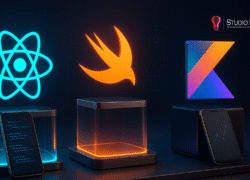As a lead developer at StudioKrew, I have spent the past decade building mobile games, multiplayer platforms, AR/VR experiences, and real-money gaming systems for clients worldwide. One thing I’ve consistently observed is that successful projects start with one critical decision — choosing the right game development company.
In 2025, the gaming ecosystem will be more dynamic than ever. From hyper-casual mobile games to AI-integrated simulations, the scope is vast, and the stakes are high. Whether you’re a startup founder, product manager, or enterprise innovator, this guide will help you navigate the critical factors when selecting your game development studio.
Define Your Game Vision, Platforms, and Goals
Before reaching out to any game studio, invest time in understanding your own game vision. This stage isn’t just about ideas — it’s about aligning expectations, resources, and technical feasibility from day one. As a developer, I can tell you that clarity on your end saves months of back-and-forth later and sets the tone for the entire project lifecycle.
Here’s what you should prepare or expect help with:
- A detailed Game Design Document (GDD) to define the storyline, features, characters, and mechanics
- A Software Requirements Specification (SRS) that outlines the technical functionality, flow, and system architecture
- Platform targeting: Mobile, Web, Console, or Cross-platform?
- Gameplay mode: Single-player, real-time multiplayer, MMO, or PvP?
- Any use of AR/VR, AI, Web3, or real-money mechanics?
When these elements are clearly defined upfront, it becomes significantly easier to find an appropriate game development company or hire game developers. At the same time, it would support developers in suggesting the right game engine, estimating timelines, building the right team, and preparing your game for scalability.
Pro Tip:
Projects like GoldeFy (a Massive Multiplayer Online Metaverse mobile game) were only possible because the mobile game developers in India were chosen. The client came prepared with a strong conceptual foundation and collaborated with our team during discovery sprints to finalize a clear, technically viable execution plan.
Before reaching out to any game studio, invest time in understanding your own game vision. As a developer, I can tell you that clarity on your end saves months of back-and-forth later.
- Is your game 2D, 3D, or a hybrid of both?
- Should it be single-player, multiplayer, or MMO?
- Are you targeting mobile only, or is this for cross-platform (WebGL, PC, console)?
- Any additional feature required like NPCs, AI-integrated game mechanics or ML-based mechanics, bots, or any other core functional point.
Review Technical Capabilities and Game Engine Expertise
Look for game development companies that offer hands-on experience with engines such as Unity (for 2D/3D, AR/VR, and mobile), Unreal Engine (known for its AAA-quality graphics and multiplayer capabilities), or Phaser for web games. Companies such as StudioKrew also leverage advanced frameworks like Photon Fusion for real-time multiplayer games, in addition to custom engines tailored for HTML5, console, and OTT platforms. Having profound technical knowledge is crucial to ensure your game is optimized for both performance and scalability.
The technology stack accounts for approximately 80% of your project’s scalability, performance, and potential for future updates.
At StudioKrew, we specialize in:
- Unity – Our go-to for cross-platform game development services
- Unreal Engine – Preferred for photorealistic 3D and console games
- Photon Fusion, WebSocket, Mirror – For real-time multiplayer logic
- Node.js + Redis + MongoDB – Our standard backend trifecta
- ARKit / ARCore / Unity XR – AR/VR support for immersive experiences
When reviewing a company, check:
- Engine fluency (Unity, Unreal, Godot)
- Multiplayer stack
- Backend strength
- Cross-platform deployment history
Ask for Industry-Relevant Portfolio & Case Studies
A portfolio tells you whether the studio walks the walk. Look for:
- Projects similar to yours (genre, mechanics, platforms)
- Performance benchmarks (DAU, concurrency, retention)
- Custom features like wallet integration, in-app monetization, or 3D spatial logic
For example, in Taubola, we engineered a real-time Bingo game capable of handling 10,000+ concurrent players per room using Unity + Socket.IO + Redis—with S3 streaming and optimized matchmaking.
Evaluate Their Engagement Models and Communication
Game mechanics are only half the battle. The real difference lies in how the player feels — how intuitive the controls are, how engaging the level design is, and how rewarding the feedback loops become over time. A beautiful UI is excellent, but a frictionless, emotionally resonant user journey keeps players returning.
Ask about:
- Game design documentation (GDD) support
- UI/UX designers with a gaming background
- Reward loops, in-game economies, ad vs. IAP balancing
We often conduct retention-focused design sprints to simulate user journeys before writing code. That’s a developer’s dream—building on well-tested ground.
Game Development Workflow: Agile, Feedback Loops & Transparent Collaboration
Behind the code, it’s the people and processes that matter. Transparency and iterative feedback cycles are vital. But before you even get into those cycles, it’s essential to ask your game development partner about the structure of project execution:
- Will a detailed Software Requirements Specification (SRS) be prepared, reviewed, and signed off before development begins?
- How many milestones or sprints will the project be broken into, and what are the deliverables for each?
- How frequently will client feedback sessions be conducted — weekly, bi-weekly, or per milestone?
- Will you receive game demos or builds at the end of each sprint?
- Who will be your point of contact? Will you have access to a dedicated Product Manager and Project Manager throughout the engagement?
The answers to these questions often define whether your project stays on track or becomes a communication nightmare.
Ensure your game dev partner:
- Uses Agile or Scrum methodology
- Shares progress via tools like Jira, ClickUp, or Trello
- Has real-time communication channels (Slack, Teams)
- Provides sprint demos and regular builds for review
At StudioKrew, we prefer shipping progressive builds every 7–10 days. This allows clients to playtest early and course-correct quickly.
Check Reviews, Ratings, and Client Testimonials
One of the most effective ways to validate a game development company’s credibility is to see what others say about it. Reviews and testimonials offer real-world insights into a studio’s ability to deliver, communicate, and adapt.
Where to Check:
- Clutch.co: Detailed, interview-based reviews covering quality, cost, scheduling, and willingness to refer
- GoodFirms & DesignRush: Rankings based on client feedback and service scope
- Google Reviews: Quick reputation check from local and international clients
- LinkedIn Recommendations: Authentic peer-to-peer endorsements
What to Look For:
- Recurring praise for delivery reliability, technical skill, or creative problem-solving
- Testimonials mentioning specific milestones, tech stacks, or post-launch support
- Reviews from brands or industries similar to yours
At StudioKrew, we’re proud to have consistently high ratings across platforms. Our clients often commend our proactive communication, milestone ownership, and ability to turn ideas into market-ready games.
Understand Post-Launch Support & LiveOps
One of game development’s most overlooked yet critical aspects is what happens after launch. Many studios stop at deployment, but experienced partners know that LiveOps is where actual user value and longevity are built.
Here’s what robust post-launch support should include:
Game Analytics & Player Insight
- Integration with tools like Firebase, GameAnalytics, or Mixpanel
- Real-time dashboards to track DAU, retention, in-app purchases, and churn rates
- Event-based analytics to monitor feature performance and optimize gameplay
Live Content & Seasonal Updates
- Roll out seasonal events, new levels, limited-time offers, and holiday themes to keep engagement high
- Enable backend content management so non-developers can update visuals and rewards
A/B Testing & Monetization Tweaks
- Run experiments on UI changes, ad frequency, IAP pricing, and user flow
- Use analytics insights to maximize revenue without hurting player experience
Player Retention Tools
- Implement daily login bonuses, push notifications, and progression systems
- Integrate LiveOps platforms like PlayFab or Leanplum for data-driven engagement
Maintenance & Bug Fixing
- Immediate patch cycles for critical bugs
- Weekly or bi-weekly update schedules for performance improvements and new features
At StudioKrew, we see launch not as a finish line but as the start of a live relationship with your players. Our Game LiveOps services plans are customized per client and typically span 3–6 months post-deployment — often longer if you’re scaling a live multiplayer ecosystem or monetized game.
Ask your potential development partner about their LiveOps philosophy, tech stack, update frequency, and how they plan to grow your game after Day 1. It’s often the difference between a one-hit wonder and a long-term gaming brand.
LiveOps is more than bug fixes. It includes:
- Player analytics (Firebase, GameAnalytics, Mixpanel)
- Content updates (seasonal, event-driven)
- A/B testing, reward systems, push notifications
We treat the launch as Day 1, not the end. A good studio should commit to post-launch optimization, even if just for 3–6 months.
Global Reach & Localization Capabilities
Today’s games are played across continents, cultures, and devices, making global readiness a non-negotiable part of your development strategy. In 2025, your audience isn’t just local; it’s worldwide. The right game development company should be capable of designing and deploying games that adapt to global markets while complying with regional regulations.
What to Look For:
- Localization and Multilingual Support: Ensure the studio can integrate multi-language UI/UX, culturally relevant content, and character adaptations for various regions.
- Multi-Currency and Regional Payments: Support for in-app purchases and payment gateways that align with local user behaviour and regulations.
- Compliance Awareness: Understanding GDPR, COPPA, and real-money gaming laws in countries like the USA, UK, India, UAE, and more.
- Infrastructure for Global Delivery: Use global CDNs, edge networks (like AWS CloudFront or GCP), and failover systems to ensure seamless gameplay regardless of geographic location.
- Timezone-Friendly Collaboration: Look for a team that can adapt its working hours, offer 24/7 support coverage, and manage updates according to peak regional usage.
At StudioKrew, we’ve helped launch games across the USA, UK, UAE, Australia, and India with localized content strategies and region-specific backend logic. We understand that one size doesn’t fit all — and we architect our games to scale and succeed across markets.
Conclusion: Choose Technically, Collaborate Creatively
Choosing the right game development company isn’t just a procurement decision — it’s a creative alliance. You’re not simply outsourcing code; you’re co-creating an experience that will live on users’ devices, influence their emotions, and shape your brand.
From the moment you define your vision and technical requirements to choosing the right game engine and team to the post-launch support that drives player retention. Every step should be rooted in transparency, mutual trust, and a shared goal: delivering something exceptional.
At StudioKrew, we don’t operate like a traditional vendor. We embed ourselves in your product thinking, co-own your delivery goals, and back it all with technical and creative firepower that scales. Whether it’s real-time multiplayer, a gamified learning app, or an immersive AR/VR experience, we think beyond the code — we think about impact.
So when you’re ready to build a game that’s not only technically sound but emotionally resonant, creatively ambitious, and globally scalable — we’re here to help you lead that journey.
🎯 Contact StudioKrew, and let’s shape the future of play together.





